The guide covers how to customize the Folder pane in Outlook: from changing its font size to expanding, minimizing, or hiding it.
If you spend a lot of time in Outlook, the way you navigate between your mailboxes and folders can either slow you down or help you breeze through tasks. As simple and straightforward as the Outlook Folder pane looks, it does have a few handy settings tucked away. With just a few quick adjustments, you can make the text larger, expand or collapse folders, or hide the pane completely when you need extra space.
What is Folder pane in Outlook?
The Folder Pane is the vertical panel on the left side of the Outlook window that holds all your mail folders, such as Inbox, Sent Items, Drafts, Deleted Items, plus any custom folders you've created. If you use more than one account, each mailbox has its own set of folders in this pane.
In earlier versions of Outlook, this pane could also include Calendar, Contacts, and Tasks icons beyond mail folders. In Outlook 365, those icons are placed to the left of the Folder pane by default, though they may appear at the bottom instead, depending on how your Navigation bar is set up.
In short, the Folder pane is the place for navigating between different items in Outlook.
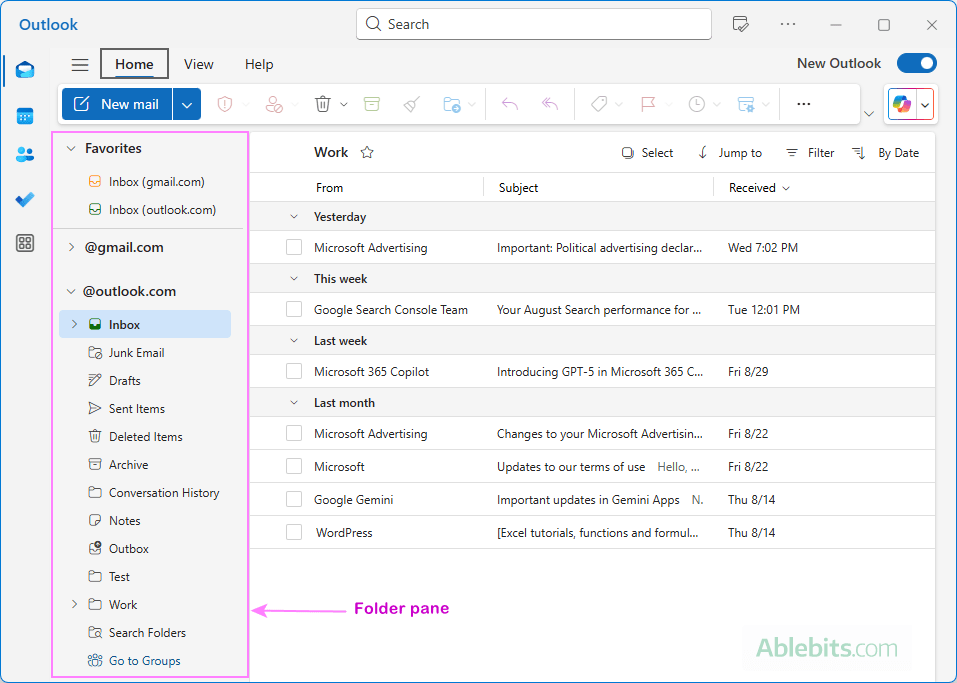
How to change Folder pane in Outlook
In classic Outlook, you can change the appearance of the folder pane and how much space it takes using this setting:
- On the View tab, in the Layout group, click Folder Pane.
- Choose one of these options:
- Normal – the default view, showing your full list of mail folders.
- Minimized – reduces the pane to a thin bar that displays only your Favorites.
- Off – hides it completely.
- Additionally, you can choose whether to show or hide Favorites in the list of folders.
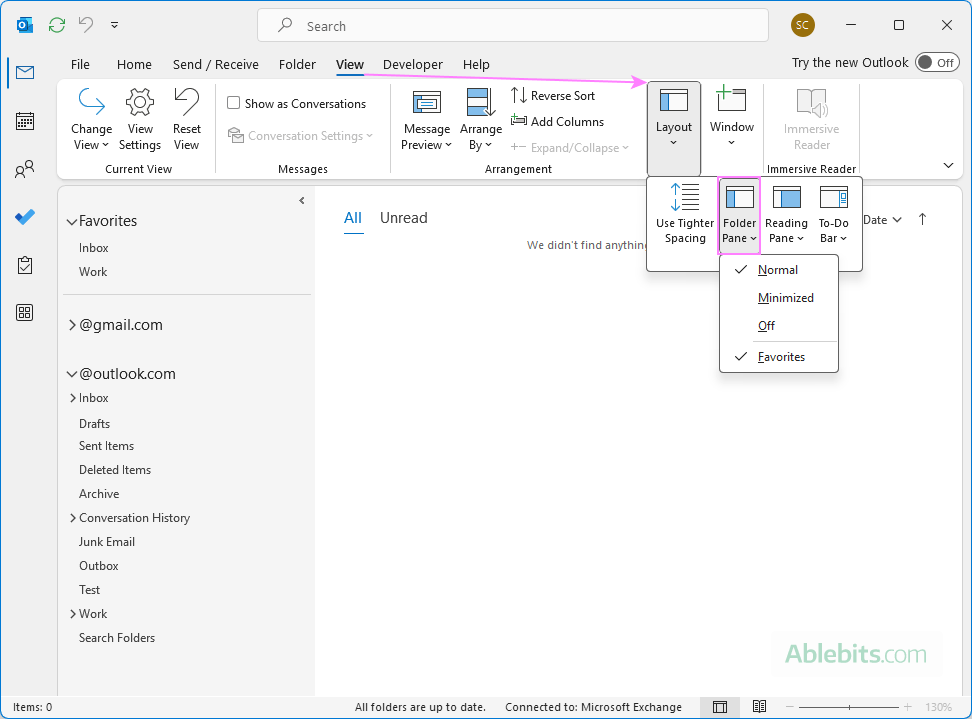
Manage the minimized Folder pane
When the Folder pane is minimized in Outlook, you can handle it in this way:
- Expand Folder pane. Click the small arrow at the top of the pane to temporarily expand it.
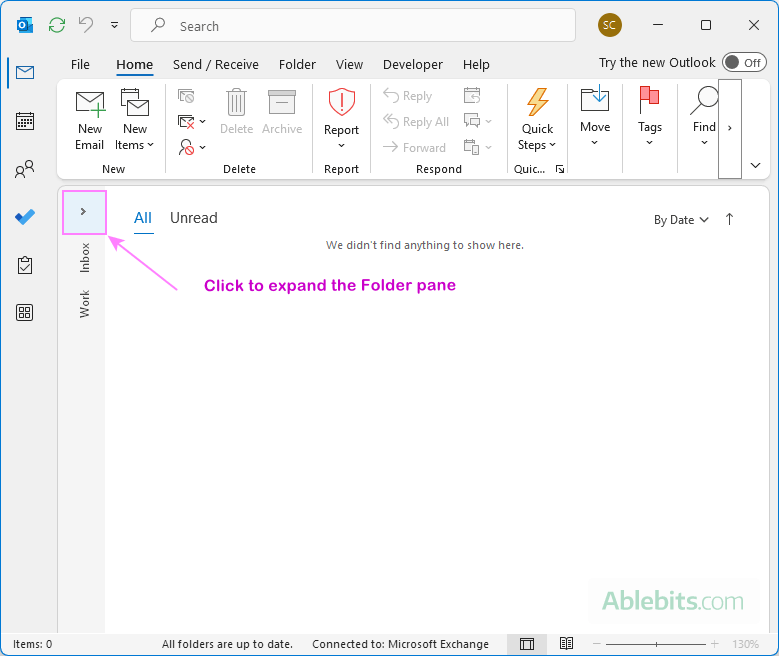
- Pin Folder pane. If you want to keep the folder pane expanded, click the Pin icon. This works the same as choosing Normal from the ribbon.
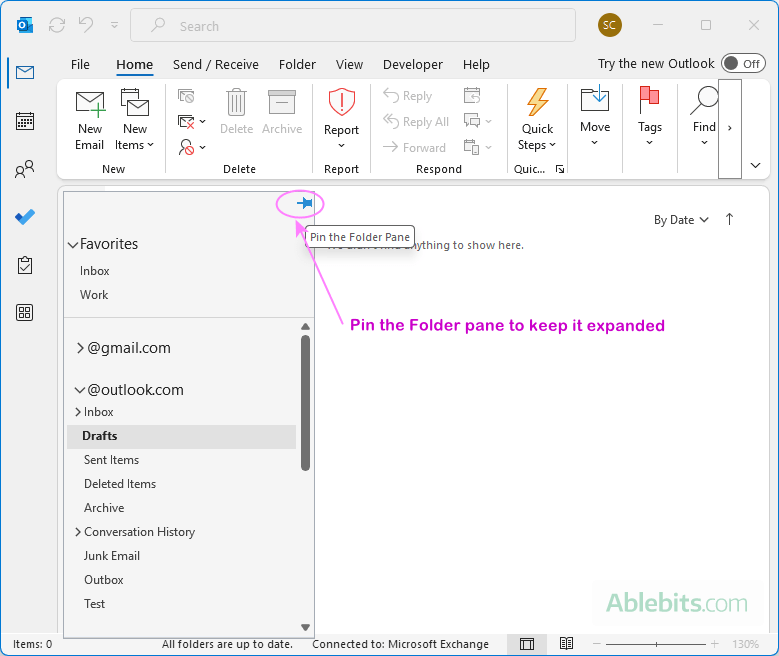
Outlook will remember your choice and display the Folder pane in that state the next time you open the app.
Tip. If you do not like the default folder arrangement, you can sort them alphabetically or create a custom order. For full details, How to sort folders in Outlook.
How to manage Folder pane in new Outlook and web
The new Outlook and web app handle the Folder pane a little differently than the classic desktop application. You can't minimize the pane into a thin bar, only show or hide it completely. However, there is a handy option to arrange folders alphabetically or in custom order.
Hide and show Folder pane
The fastest way to hide the folder pane in the new Outlook and web is to click the Hamburger button (three horizontal lines) in the upper-left corner. To bring the pane back, click that button again.
Alternatively, go to the View tab > Folder pane > Folder list, and select Show or Hide.
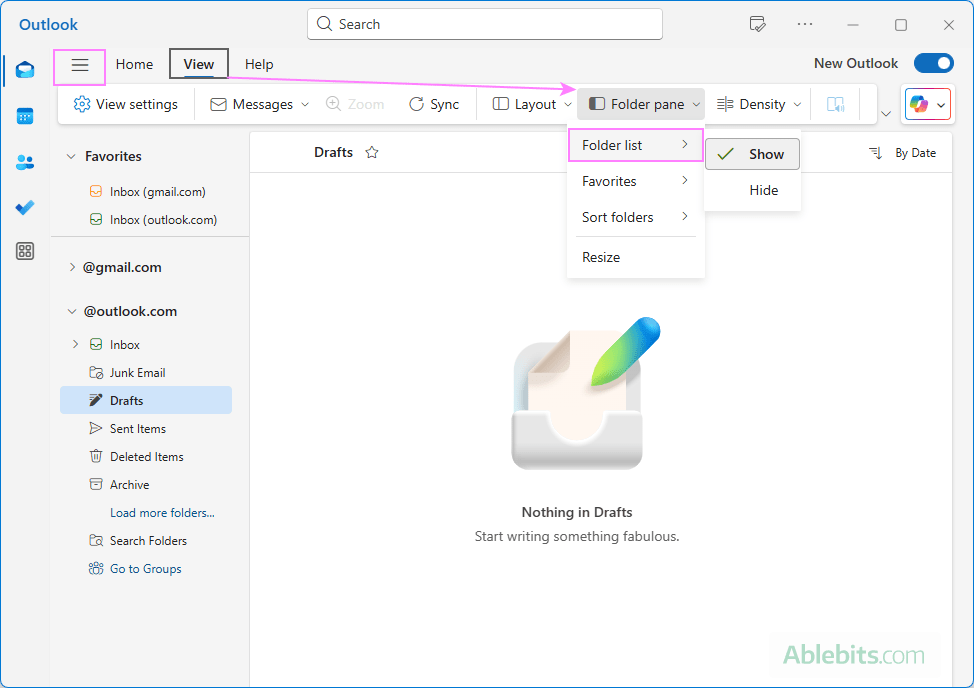
Manage Favorites
The Favorites section helps you keep important folders at hand. To adjust it:
- On the View tab, select Folder pane > Favorites.
- Choose one of these options:
- Show – displays Favorites at the top of your folders.
- Hide – removes the Favorites section from view.
- Pin – keeps Favorites always visible as you scroll through the folder list. Unpin it when you don't want it fixed at the top.
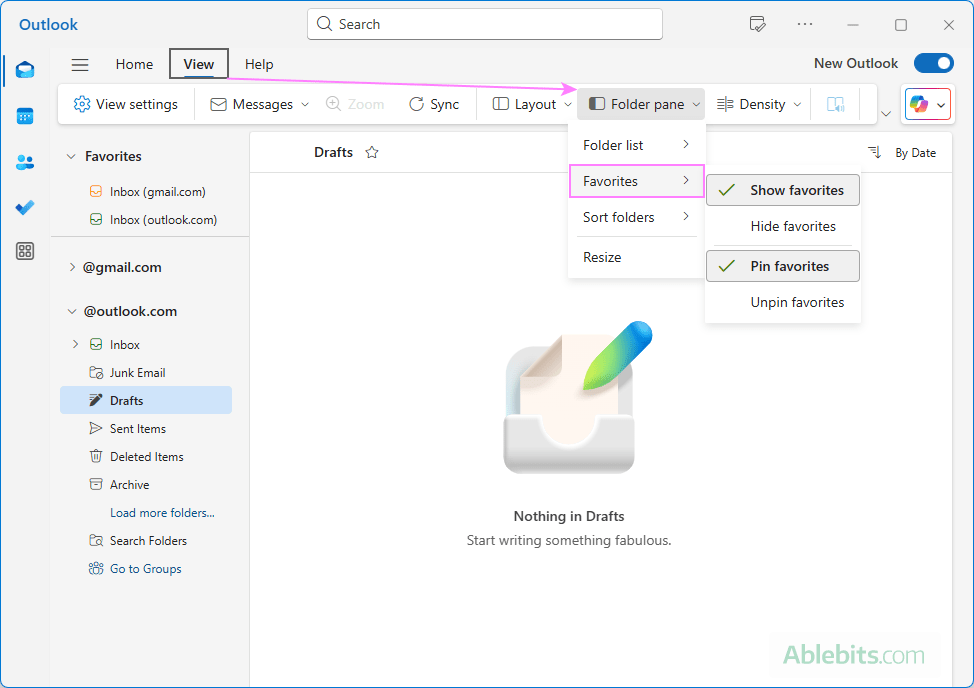
Sort Outlook folders alphabetically or in custom order
You can choose to keep your folders neatly alphabetical or arrange them in your preferred way:
- On the View tab, click Folder pane > Sort folders.
- To sort folders alphabetically, select Order folders A to Z.
- To use a Custom folder order, select that option, and then:
- Drag and drop a folder to the new position, or
- Right-click the folder and choose Move up or Move down from the context menu.
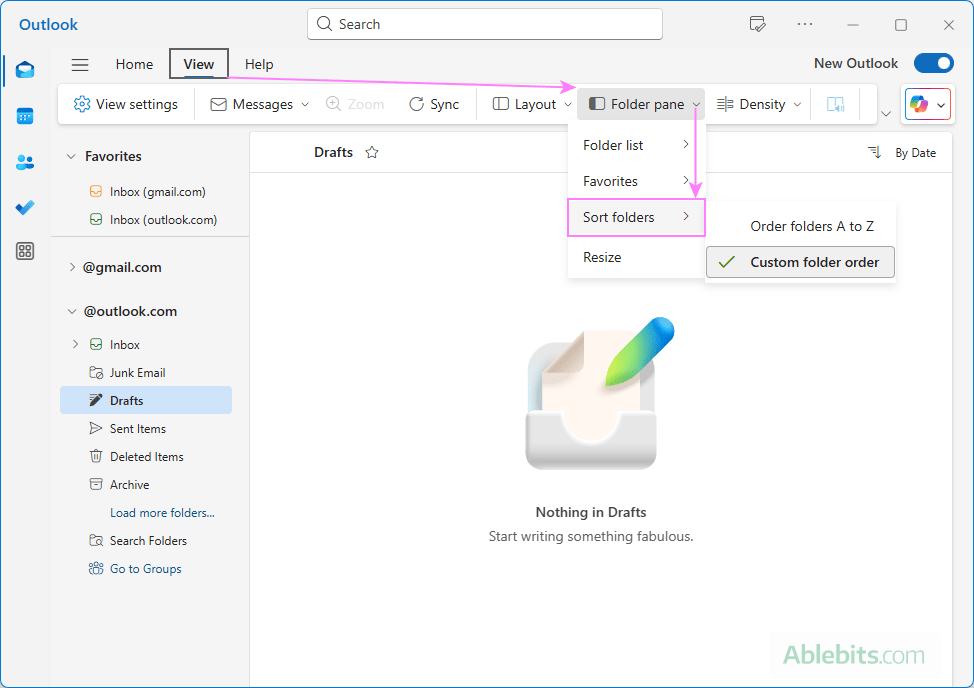
This lets you choose between the predictability of alphabetical order or the convenience of having your most used folders right where you want them.
Outlook Folder pane shortcut
If you want to quickly adjust the Folder pane in Outlook, there's a handy shortcut you can use: ALT + F1
This works across all versions of Outlook, including the classic desktop app, the new Outlook, and Outlook on the web.
- Classic Outlook: The shortcut cycles through three states – Normal, Minimized, and Hidden.
- New Outlook and Outlook on the web: The shortcut toggles the Folder pane on or off.
Try pressing ALT + F1 a few times to see the different views in action.
How to change Folder pane font size in Outlook 365 - 2016
If the folder names in Outlook look too small and are hard on your eyes, you can make them bigger. Here's the key point up front: Outlook itself doesn't have any setting to adjust the Folder pane text size in any version. But it can be easily done using your computer's Display settings.
- Close Outlook before making changes.
- Right-click your desktop and choose Display settings. Alternatively, you can go a longer way: Start > Settings > Display.
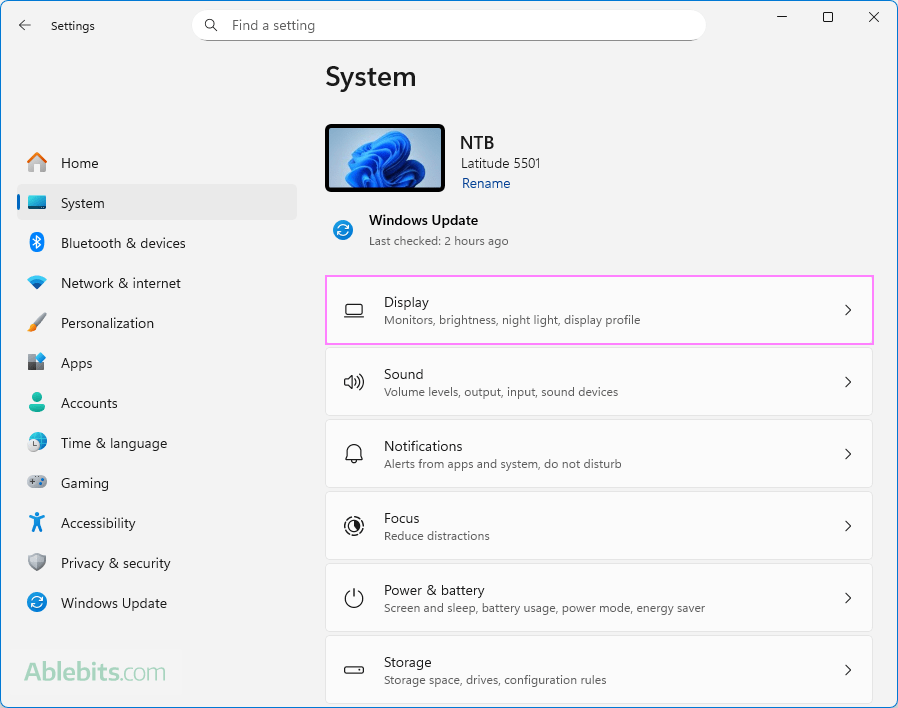
- Make everything bigger. Scroll down to the Scale & layout section and, from the Scale dropdown, select a desired scaling percentage, for example 125% or 150%.
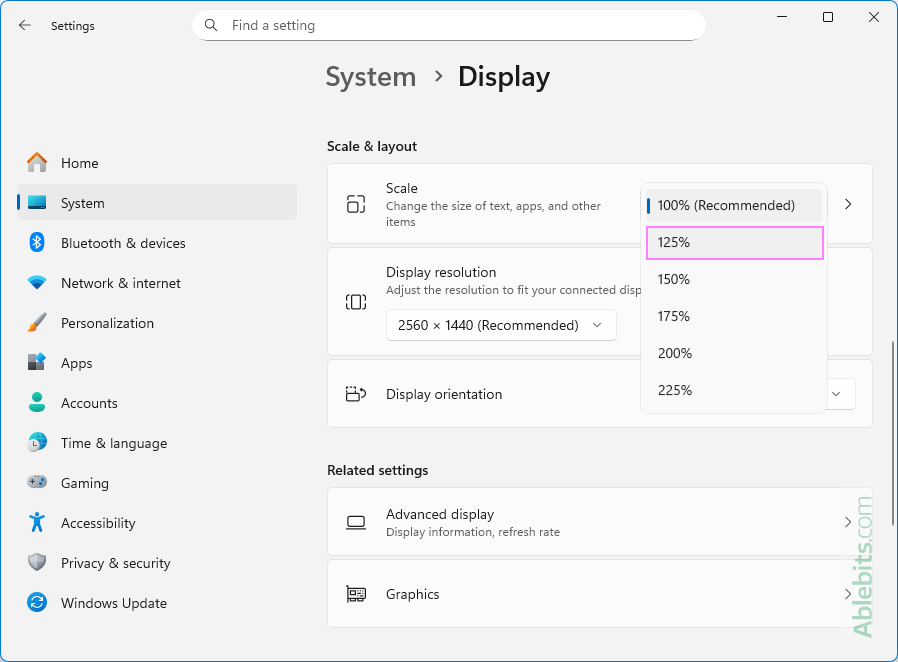
This will make everything on your screen bigger, including desktop icons, app names, and the folder names in Outlook. If you do not want to change the size of all items on the desktop, skip this step.
- Increase text size. To fine-tune only the text size without scaling everything, do this:
- In the same Display settings window, click the arrow next to Scale.
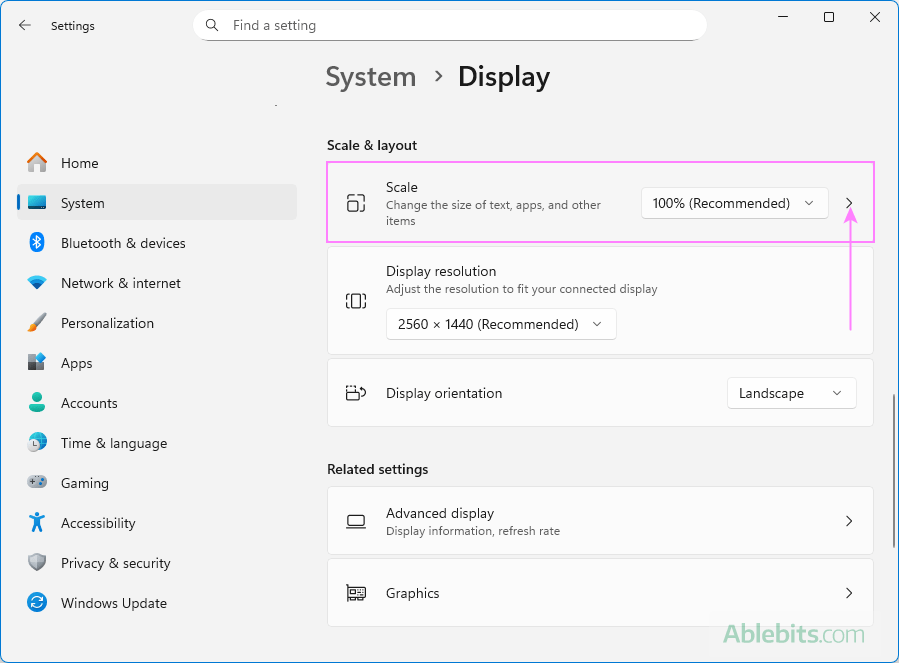
- Under Related settings, click Text size.
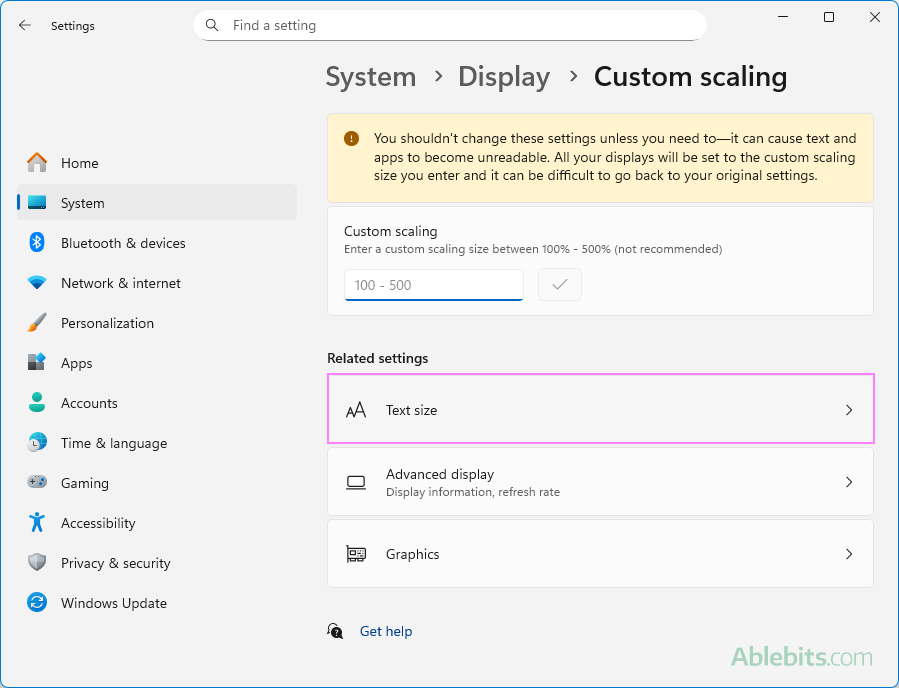
- Use the Text size slider to increase the font size. The preview text at the top will change as you adjust. Once you're happy with the size, click Apply.
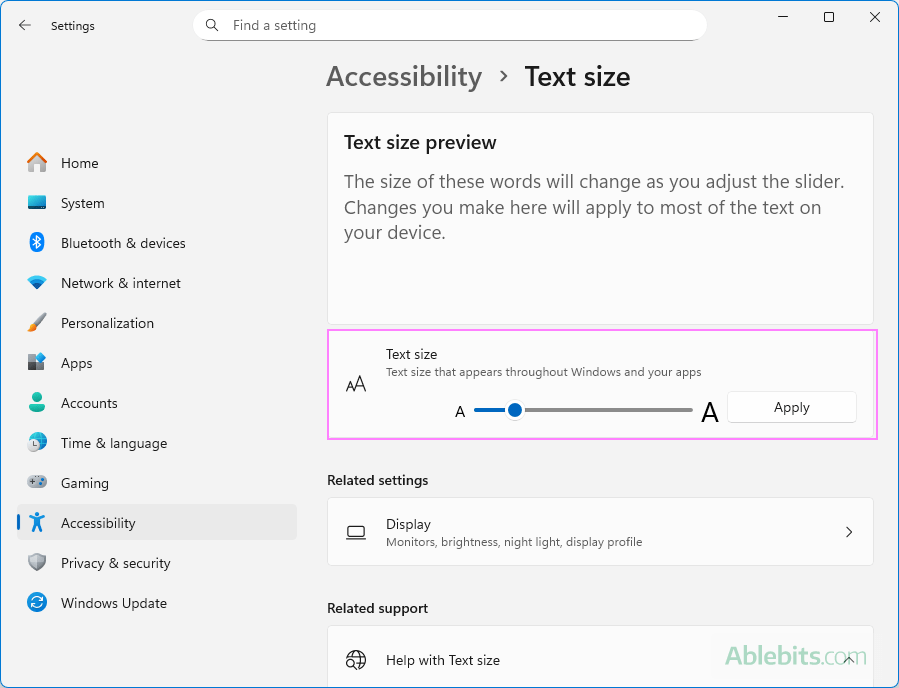
- In the same Display settings window, click the arrow next to Scale.
- Finally, reopen Outlook and check your Folder pane.
The folder names should now appear larger and much easier to read.
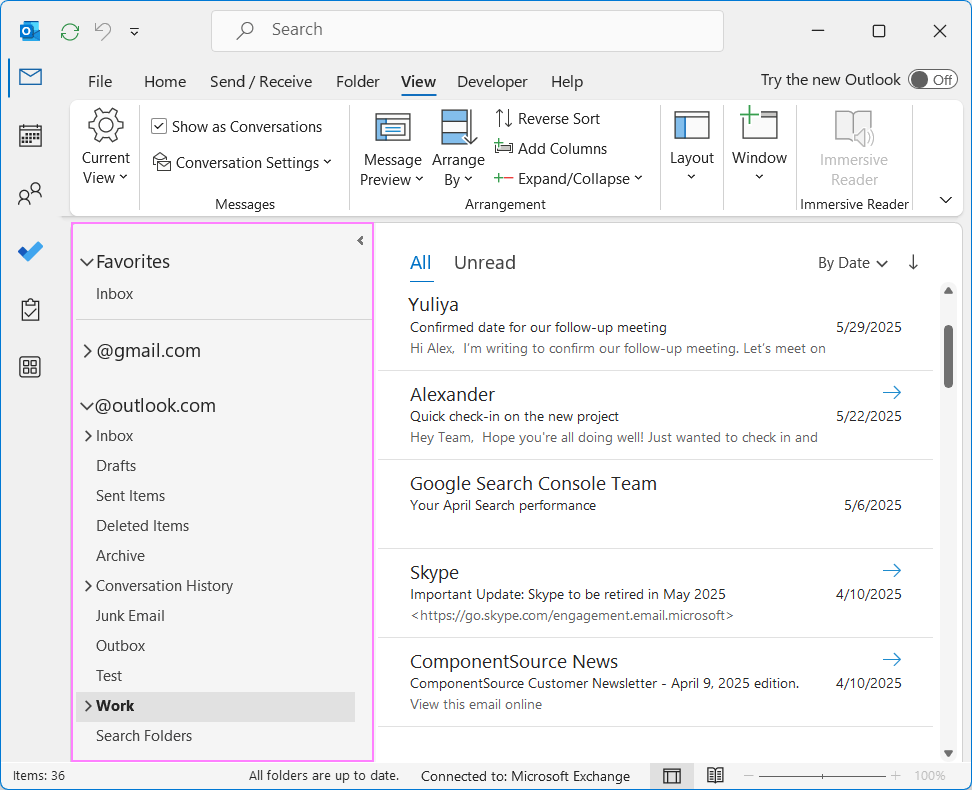
Note. This change affects both the classic and new Outlook, as well as other apps on your computer. Menus, text, and icons across Windows will also appear larger.
How to increase Folder pane font size in new Outlook and web
Unlike the classic version, the new Outlook includes its own setting to change text size and spacing inside the app. This lets you customize the Folder pane without changing your entire system display.
- Click the Settings gear icon in the upper right corner of the new Outlook.
- In the Settings window, go to Mail > Layout.
- Under the Text size and spacing section, select Small, Medium (default) or Large.
- Click Save to apply your changes.
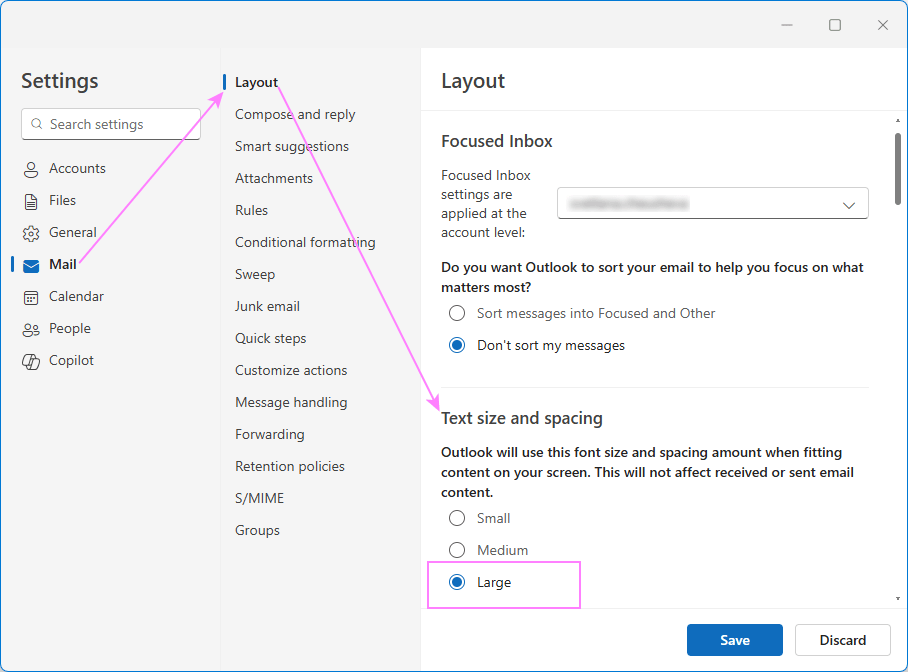
The text size in the folder names and message list will change right away.
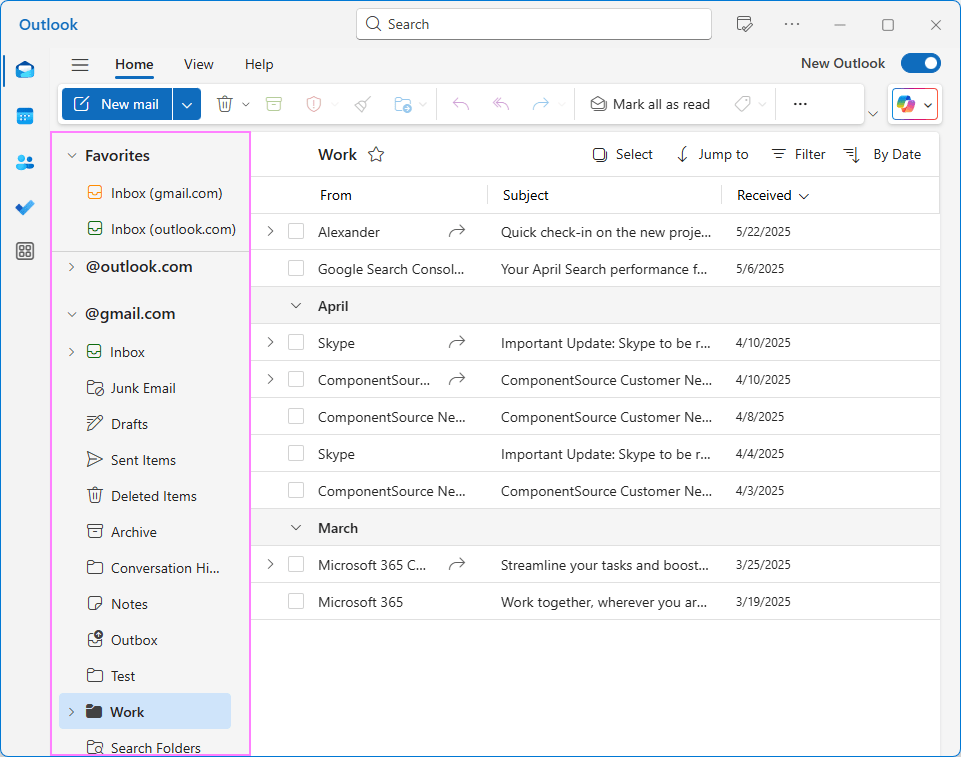
Note. This setting does not affect the text size in the Reading pane or the message compose window, only the Folder pane and the list of emails.
How to resize Folder pane
If the Folder pane is too wide or too narrow in your Outlook, you can easily adjust its size to better fit your needs.
- Place your cursor to the right edge of the Folder pane.
- When the pointer changes to a double-headed arrow, click and drag left or right until the pane is the size you prefer.
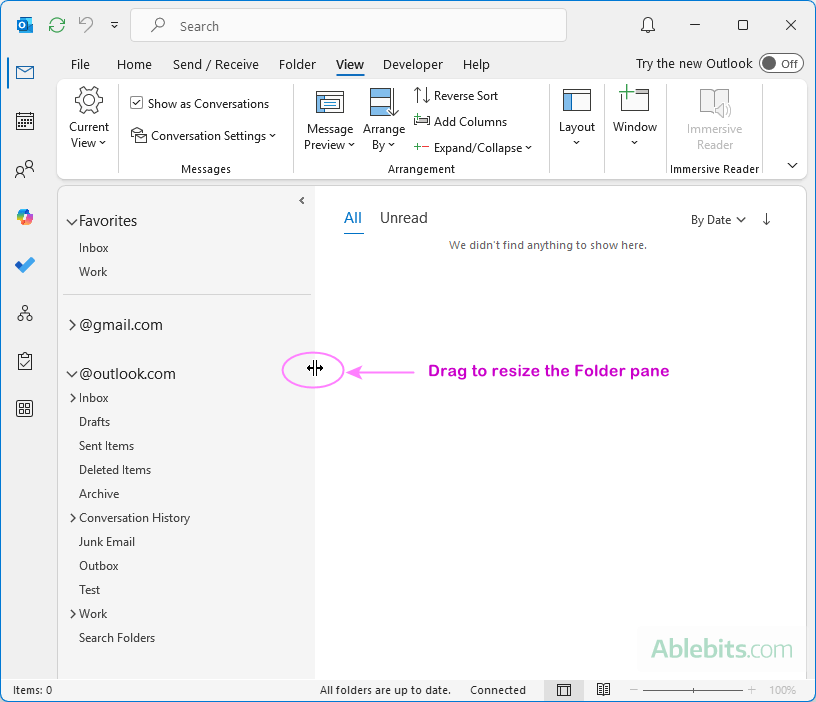
In the new Outlook and the web app, there's also a built-in resizing option for easier control:
- On the View tab, click Folder pane > Resize.
- A thick vertical line will appear, showing the boundary of the pane. Drag this line to adjust the width to your liking.
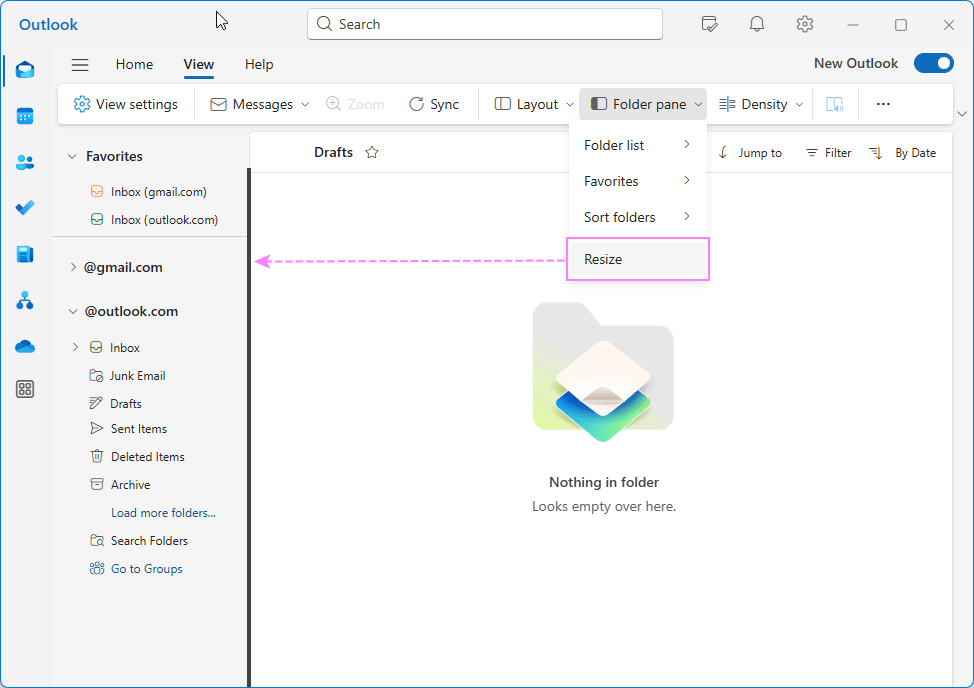
Expanding or collapsing folders
If you work with lots of folders and subfolders in Outlook, here's how you can expand or collapse them:
- Click the small triangle next to a folder to expand it and see its subfolders.
- Click it again to collapse and hide subfolders.
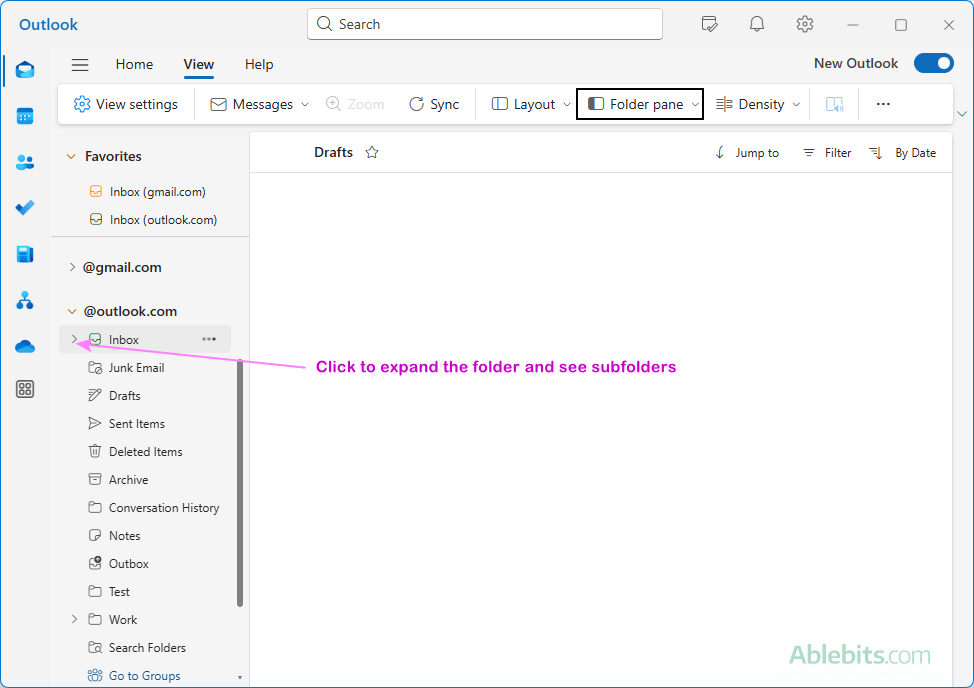
Change Outlook's startup folder
By default, Outlook opens to the Inbox of your primary account, giving you immediate access to new messages. But you can change this to start in any other folder you like, for example a specific project folder, or one of your Search folders.
To configure the startup folder, follow these steps:
- Go to File > Options.
- Head over to Advanced.
- In the Outlook start and exist section, find the Start Outlook in this folder option.
- Click Browse and select the folder you want Outlook to open by default.
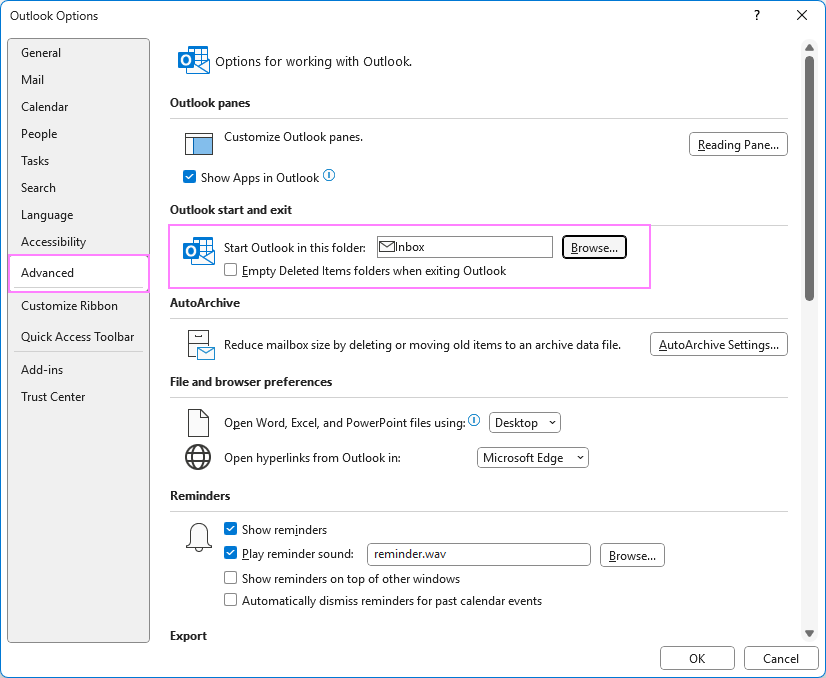
Note. This option is only available in classic Outlook, not in the new Outlook or web app.
Folder pane missing in Outlook
If you can't see the Folder pane in Outlook, don't worry, it's usually just hidden, not gone. Getting it back is simple:
- Press the ALT + F1 shortcut that quickly toggles the Folder pane on or off.
- Use the Folder pane settings on the View tab of the ribbon.
If the list of folders is still missing, try restarting Outlook:
- Close Outlook completely.
- Open Task Manager and ensure no Outlook processes are still running.
- Reopen Outlook.
If the pane still doesn't appear, make sure your Outlook is updated to the latest version, as updates often fix display or layout issues.
With these adjustments, you can make the Outlook Folder pane work the way you prefer. Resize, minimize, or customize it, and you'll spend less time searching and more time getting things done 😊
 by
by
One comment
Alexander, You have GREAT information in your posts/website. I've recently purchased a Windows 11 laptop and I've learned a lot from your posts. Your Screen Shots and Annotations with Arrows have been especially helpful.
Thank You!
Mike